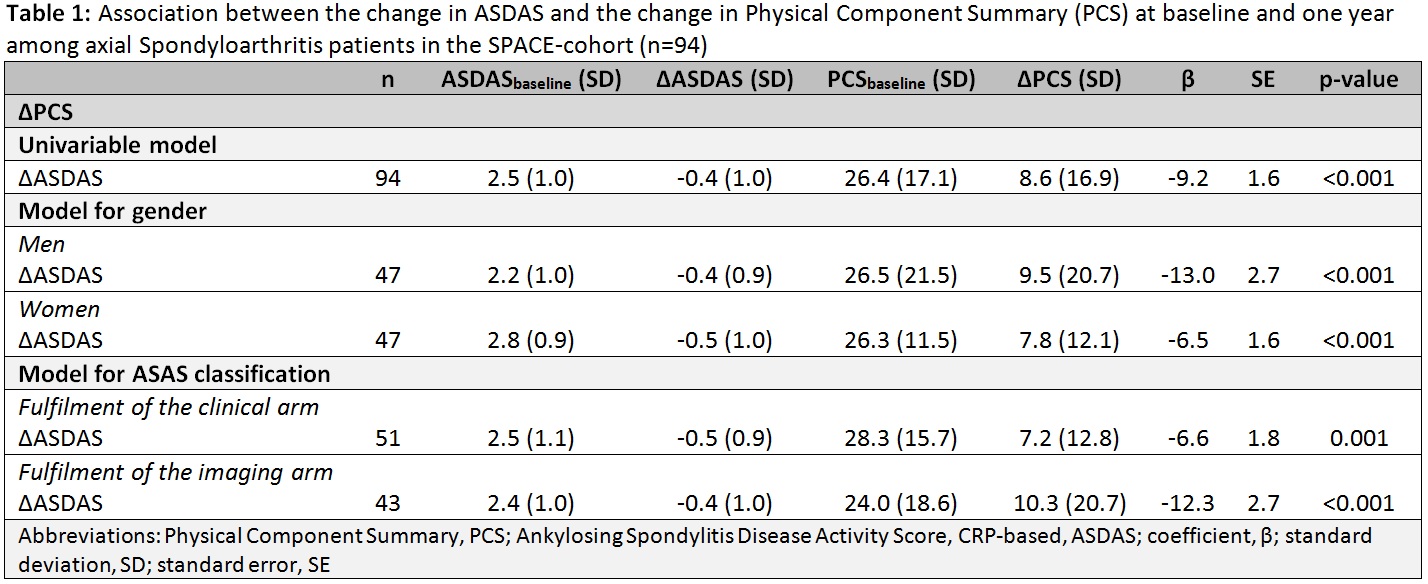Session Information
Session Type: ACR Poster Session A
Session Time: 9:00AM-11:00AM
Background/Purpose: In axial Spondyloarthritis (axSpA), treatment is targeted at reducing disease activity with the aim of improving the health-related quality of life (HRQoL). Therefore, it is very important to know if a change in disease activity is indeed related to a change in HRQoL. The aim is to assess the association between the change in disease activity and change in HRQoL between baseline and one year in patients with early axSpA.
Methods: The Spondyloarthritis Caught Early (SPACE) study is a prospective cohort study in patients with chronic back pain (≥3 months, ≤2 years, onset <45 years) recruited from various rheumatology centers across Europe. The 36-item Short-Form (SF-36) was completed by patients to assess HRQoL at baseline and one year. Physical (PCS) and Mental Component Summary (MCS) scores were calculated (adjusting converted scale scores for country, gender, and age) and were compared to the general population mean of 50 with a standard deviation (SD) of 10. The Ankylosing Spondylitis Disease Activity Score (CRP based; ASDAS) was calculated to assess disease activity. Linear regression models were made with change of ASDAS between baseline and one year (DASDAS) as a determinant and the change of PCS (DPCS) or MCS (DMCS) as an outcome. The models were adjusted for age. Fulfilment of the imaging or clinical arm and gender were tested for interaction.
Results: A total of 94 patients fulfilled the ASAS axSpA criteria; 51 patients fulfilled the clinical arm and 43 patients the imaging arm. Mean age was 29.4 years (SD 7.2), 50.0% was male, and mean duration of back complaints was 14.8 months (SD 8.9). As the MCS was not different from the general population (baseline: 50.1 (SD 13.0); one year: 50.3 (SD 11.7), only the effect of ASDAS on PCS was determined. Patients had a mean PCS of 26.4 (SD 17.1) and mean ASDAS of 2.5 (SD 1.0) at baseline (Table 1). Differences in ASDAS between men (2.2) and women (2.8) and in PCS between clinical arm (28.3) and imaging arm (24.0) were found. DPCS was different between men and women, clinical and imaging arm. In the univariable model, a decrease of one unit of ASDAS between baseline and one year resulted in an improvement in PCS of 9.2 (SE 1.6) over one year. Fulfilment of the clinical or imaging arm (p=0.036) and gender (p=0.082) were effect modifiers in the model for PCS. Results were stratified for these variables. The effect of DASDAS on DPCS was most pronounced in men (β=-13.0; SE 2.7) and patients fulfilling the imaging arm (β-12.3.8; SE 2.7). It was also significant in women (β= -6.5; SE 1.6) and patients fulfilling the clinical arm (β=-6.6; SE 1.8) but the effect sizes were smaller.
Conclusion: In axSpA, a decrease in disease activity is associated with a clear improvement in health-related quality of life, but the effect is the highest in men and patients with imaging abnormalities.
To cite this abstract in AMA style:
van Lunteren M, Ez-Zaitouni Z, Bakker P, Dagfinrud H, Landewé R, van Oosterhout M, Ramonda R, van Gaalen F, van der Heijde D. Does Change in Disease Activity over One Year Result in Change in Health-Related Quality of Life in Early Axial Spondyloarthritis Patients? [abstract]. Arthritis Rheumatol. 2016; 68 (suppl 10). https://acrabstracts.org/abstract/does-change-in-disease-activity-over-one-year-result-in-change-in-health-related-quality-of-life-in-early-axial-spondyloarthritis-patients/. Accessed .« Back to 2016 ACR/ARHP Annual Meeting
ACR Meeting Abstracts - https://acrabstracts.org/abstract/does-change-in-disease-activity-over-one-year-result-in-change-in-health-related-quality-of-life-in-early-axial-spondyloarthritis-patients/

